Oklahoma sits at the crossroads between Eastern and Southern snake species. The state is home to many species, particularly in its Western parts.
Snakes are found in woodlands and abandoned crops here. They are also very common next to marshes, ponds, and streams.
Various species of terrestrial and aquatic snakes are found here. Some of them live even longer than 10 years.
Table of Contents
Are There Venomous Snakes in Oklahoma?
The majority of snakes in Oklahoma aren’t venomous.
However, there are a few species that are highly venomous across the state, including less inhabited parts in Western Oklahoma.
Northern Cottonmouth and Broad-banded Copperhead snakes are just a couple of venomous specie in the state.
Pit vipers grow here and staying away from them is mandatory as they can have a lethal effect in some cases.
While rare, venomous snake bites across the state require medical attention.
Snakes in Oklahoma
The following species of venomous and non-venomous snakes are most common across Oklahoma.
1. Western Ratsnake

Scientific name: Pantherophis obsoletus.
Venomous: No.
This non-venomous species is sometimes known as The Black Snake, a nickname also given to other species.
Snakes of this genus live West of the Mississippi River.
As a snake with the capacity to move across different habitats, the Western Ratsnake is known to spend time on trees while it may also swim for food.
This species uses constriction to kill small prey such as mice.
This species often overwinters with venomous snakes in dens.
It grows to a maximum length of 6 feet being one of the largest snakes in certain areas. It’s considered the longest snake in Canada.
Western Ratsnakes mate in May and June with the first eggs hatching in August.
2. Plain-bellied Watersnake

Scientific name: Nerodia erythrogaster.
Venomous: No.
This species of snake is native to the US. It lives across multiple states in the Southeastern range of the countries.
Its name is derived from its bright spotless underside.
The main color of the species might be dark gray, olive, or even black.
The colubrid snake isn’t venomous and it has an aquatic profile.
As a swimmer, it has access to foods terrestrial snakes don’t. It eats fish and other types of prey that live next to water or that live in high-humidity places such as salamanders.
While not venomous, it might still bite humans if handled. The snake can also try to release a bad smell in an attempt to keep potential predators away.
3. Dekay’s Brownsnake

Scientific name: Storeria dekayi.
Venomous: No.
This snake is named after its brown color. It shows black spots and a central dorsal stripe as well.
Native to Eastern territories of North America, the colubrid has a non-venomous nature.
It has been reported to eat numerous types of bugs and insects, which isn’t always the case of intentional feeding.
Small prey such as millipedes might end up in its stomach by accident.
This snake prefers medium and large prey.
It feeds on earthworms and even larger prey such as toads.
Weasels are among the prey these snakes might also consume in certain habitats.
Known for its robust body, this species is a short snake with many adults measuring just 12 inches.
4. Ring-necked Snake

Scientific name: Diadophis punctatus.
Venomous: No.
The Ring-necked Snake is a dual color species with a gray dorsal side and a yellow or red underside.
It tends to expose its underside whenever facing predators.
Common in almost all of the high-elevation regions of the United States, the snake is known to eat earth-dwelling prey.
It feeds on worms and slugs.
The specie has a slender short body.
It only reaches a maximum length between 10 and 15 inches as an adult.
Commonly living in burrows, Ring-necked snakes are also seen in urban areas as they might use homes to hide.
5. Western Ribbon Snake

Scientific name: Thamnophis proximus.
Venomous: No.
This type of snake has a slender body characterized by a dark color and multiple contrasting bright stripes.
The species has yellow and white stripes along its dorsal side.
Western Ribbon Snakes have a dark green color or a green-gray color.
It feeds on various types of small and large prey.
Frogs are among the largest types of prey Western Ribbon Snakes can eat.
It lures frogs out by mimicking strikes with its head.
Fish and snails are more common foods for the species as they’re easier to spot.
6. Diamondback Watersnake

Scientific name: Nerodia rhombifer.
Venomous: No.
This dark green colubrid is endemic to North America. A dark green or a green-gray color is specific to the species.
Snakes of this family are known for having black dorsal stripes as well.
Diamondback Watersnakes aren’t venomous.
They spend most of their lives close to water sources such as ponds, streams, and rivers. Swamps of the Southeast are also a common habitat for the Diamondback Watersnake.
This species is further known for its fish-based diet.
It grows sharp teeth to grab and hold onto various fish.
Given it needs to look for fish as food, this snake is found along still or slow-moving waters.
7. Rough Earthsnake

Scientific name: Haldea striatula.
Venomous: No.
This secretive snake species is endemic to Southern regions of the United States.
Reduced populations are seen across Georgia and Florida.
As a fossorial species, the snake primarily feeds on earthworms. A small species, the snake makes its way through loose earth for food.
This snake might also live under logs and rocks, in moist areas where worms might also be found.
Darker in its young life stages, this snake can be identified by its dark or even black small head.
8. Rough Greensnake

Scientific name: Opheodrys aestivus.
Venomous: No.
Rough Greensnakes are some of the smallest snakes in North America.
The species is arboreal, showing green dorsal coloring with a bright yellow ventral color.
This species can also swim but it prefers to eat bugs and insects.
The insectivore species feed on many types of arthropods and is also seen as food for other larger snakes.
Eastern Racers are among the common predators of Rough Greensnakes which have no real measures of defending themselves.
The Rough Greensnake is a non-venomous species.
9. Northern Cottonmouth

Scientific name: Agkistrodon piscivorus.
Venomous: Yes.
This snake is one of the most common venomous snakes in Oklahoma and the Southeastern United States.
Northern Cottonmouths have a very potent venom that may even kill without proper medical care.
This snake tends to coil around its tail and show its sharp fangs whenever facing humans from a close distance.
The snake is an avid swimmer and a very good terrestrial snake found miles from water as well.
It eats a mixture of prey which include fish and insects. It also feeds on the eggs of various species.
The snake shows opportunistic feeding habits based on eating whatever it can catch first.
Brown and tan colors are often seen in a combination on the body of this snake.
10. Common Garter Snake

Scientific name: Thamnophis sirtalis.
Venomous: No.
A mildly venomous species, the Common Garter Snake has venomous saliva.
This species is also adapted to surviving and eating small prey with a poisonous nature.
It can feed on various toads and newts which are known to be poisonous and may kill other snakes and animals.
The striped Common Garter Snake prefers earthworms, rodents, and even fish, on the other hand.
This is a species feeding on a wide range of animals given it has an agile nature that allows it to capture fast-moving prey.
You can find this type of snake in different habitats such as near streams, in woodlands, on abandoned farms, and in marshes.
11. North American Racer

Scientific name: Coluber constrictor.
Venomous: No.
This colubrid snake has a mostly black color and a non-venomous nature.
White or light gray coloring only contrasts the area below its head.
The snake reaches a maximum length of 60 inches and shows habitat and pre-adaptations.
As a generalist, it can be found in different open areas such as woodland clearings or open fields.
This snake shows no real food preferences as it can also eat other juvenile snakes.
It feeds on rodents and small birds first.
12. Broad-banded Copperhead

Scientific name: Agkistrodon laticinctus.
Venomous: Yes.
This is one of the rather common venomous snakes in the state.
Its hemotoxic venom is specific to pit vipers and it leads to necrosis, pain, fever, and other symptoms.
This is a species of snake which requires hospitalization in the event of a bite. Antivenin is given to those bitten by the Broad-banded Copperhead.
Avoiding this snake involves avoiding its woodland habitats. It generally prefers woodlands with streams or close to sources of water.
It’s also to get bitten by this snake at night as it’s a nocturnal species coming out for food after sunset.
The snake eats rats and small birds.
13. Speckled Kingsnake
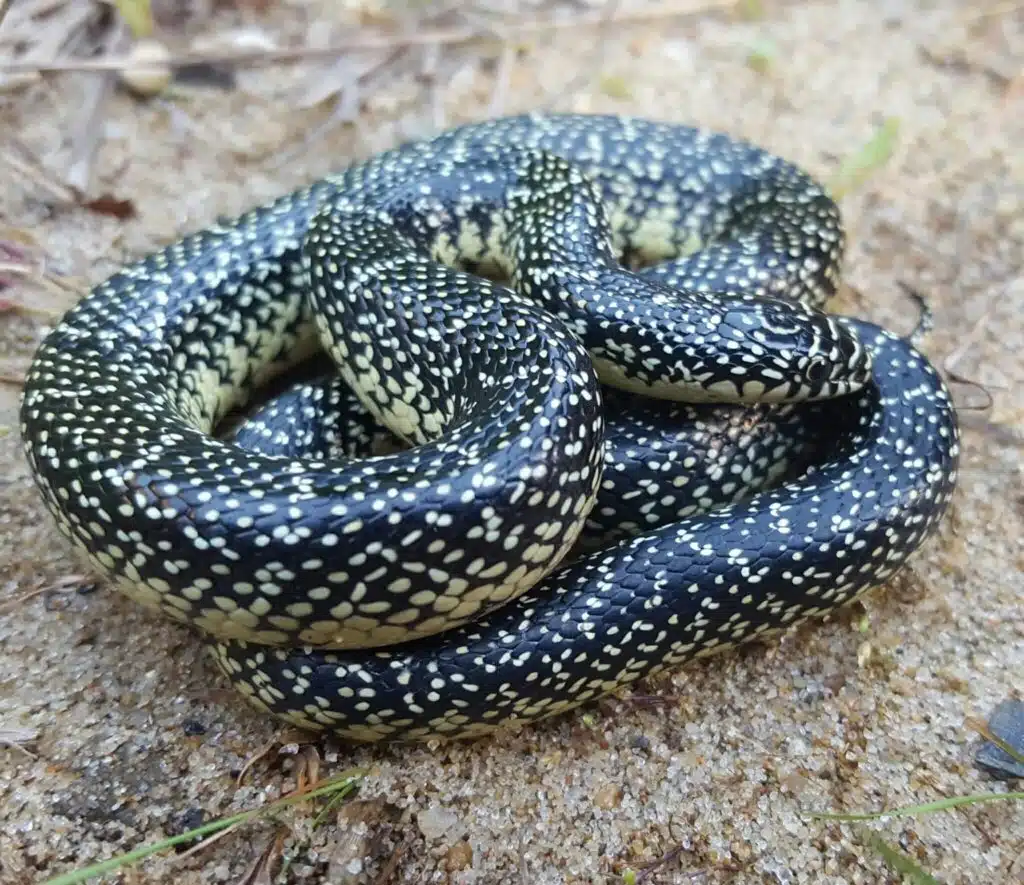
Scientific name: Lampropeltis holbrooki.
Venomous: No.
Speckled Kingsnakes are non-venomous black and white snakes.
These thick-bodied snakes grow to a maximum length of 72 inches.
Speckled Kingsnakes are found across many types of wet habitats around swamps and water sources.
It can also be found around woodlands and in dry areas up to a few miles from water.
These snakes are adapted to ward off predators by mimicking tail-shaking rattlesnakes.
Speckled Kingsnakes eat rodents and birds with occasional juveniles of other snake species.
Speckled Kingsnakes are docile snakes which makes them a common choice for those into snake pets.
14. Coachwhip

Scientific name: Masticophis flagellum.
Venomous: No.
This non-venomous snake species is named after it resembles braided whips.
Coachwhip snakes are known for their extended habitat which includes pine woodlands, oak woodlands, and wet areas such as swamps.
The species is known for its long body which places it among the largest snakes in Oklahoma.
It grows to a maximum known length of 102 inches.
Most Coachwhip snakes in the states are smaller, however. They measure around 60 inches.
This snake is known to eat small mammals. It swallows prey as soon as possible without relying on constriction.
15. Lined Snake

Scientific name: Tropidoclonion lineatum.
Venomous: No.
This type of snake is named after the bright lines across its dorsal side.
Lined Snakes have an olive-green color with gray undertones and off-white lines running from head to tail.
This species is a common sight in grasslands and other areas with soft soil.
Soft grounds are preferred by the snake due to its fossorial nature which means it spends a lot of time underground.
Its diet is limited to earthworms given it has an underground-dwelling nature.
However, the snake may not be considered a truly fossorial species in the state as it can also live above ground hidden under logs and rocks.
16. Gopher Snake

Scientific name: Pituophis catenifer.
Venomous: No.
This colubrid snake is known for having multiple rows of spots across its body.
The snake can grow to a long size of up to 7 feet but those around Oklahoma are typically shorter.
Gopher snakes are named after their main prey which is the pocket gopher.
On occasion, this snake can also eat the eggs of various species such as birds.
Gopher snakes are adapted to hunting both during the day and after sunset, but only on warm summer days.
This is also one of the species with very long lifespans across the state. It might survive for more than 10 years.
17. Western Diamond-backed Rattlesnake

Scientific name: Crotalus atrox.
Venomous: Yes.
Western Diamon-backed Rattlesnakes are one of the species with the potential to be lethal in Oklahoma.
This snake rarely injects sufficient venom to kill a person but this can happen.
Rare deaths following its bite have been recorded.
Its potent venom first impacts the circulatory system and the heart. It may also lead to muscle catabolism in some cases.
Muscle spasms and excessive bleeding are among the effects often noted with the snake’s bite.
This species is believed not to be as venomous as other rattlesnakes. Its dangerous status is balanced by its large venom glands and the capacity to inject more venom with a bite.
18. Prairie Kingsnake

Scientific name: Lampropeltis calligaster.
Venomous: No.
Prairie Kingsnakes are a non-venomous type of colubrid. While it doesn’t have any venom, it still mimics rattlesnakes by shaking its tail.
These snakes might still attempt to bite.
A semi-fossorial nature is specific to this snake.
The Prairie Kingsnake can live underground looking for earthworms. It can also live on crops or abandoned farmland away from humans.
It might attempt to release a foul smell when seeing humans.
This species grows to a short to medium size between 30 and 40 inches.
19. Pygmy Rattlesnake

Scientific name: Sistrurus miliarius.
Venomous: Yes.
Pygmy Rattlesnakes are the smallest rattlesnakes in Oklahoma. This venomous species may also be referred to as the Ground Rattler across the state.
It lives in woodlands with a preference for mixed pine and hardwood habitats.
Known for having a heat-sensing pit, this type of snake can find prey such as mice. It also eats lizards.
The snake remains small regardless of food abundance.
Pygmy Rattlesnakes grow to a length of up to 24 inches.
Camouflaging colors are the main method these snakes rely on to defend themselves.
20. Eastern Hognose Snake

Scientific name: Heterodon platirhinos.
Venomous: No.
Often confused with Pygmy Rattlesnakes, Eastern Hognose Snakes have a similar size, growing to a maximum of 28 inches.
These non-venomous species have variable colors and patterns. It can be gray, black, orange, brown, or a combined color variant.
This snake might appear in a uniform color but it can also come in patterned colors.
One of the easiest ways to identify the species is by looking at its snout, which is upturned.
This species can hiss and it can also flatten in its head whenever approached, similarly to a cobra.
Bites are rare as the snake prefers not to bite humans but to keep them away by hissing.
Eastern Hognose Snakes live long lives with an average lifespan of 12 years.
21. Timber Rattlesnake
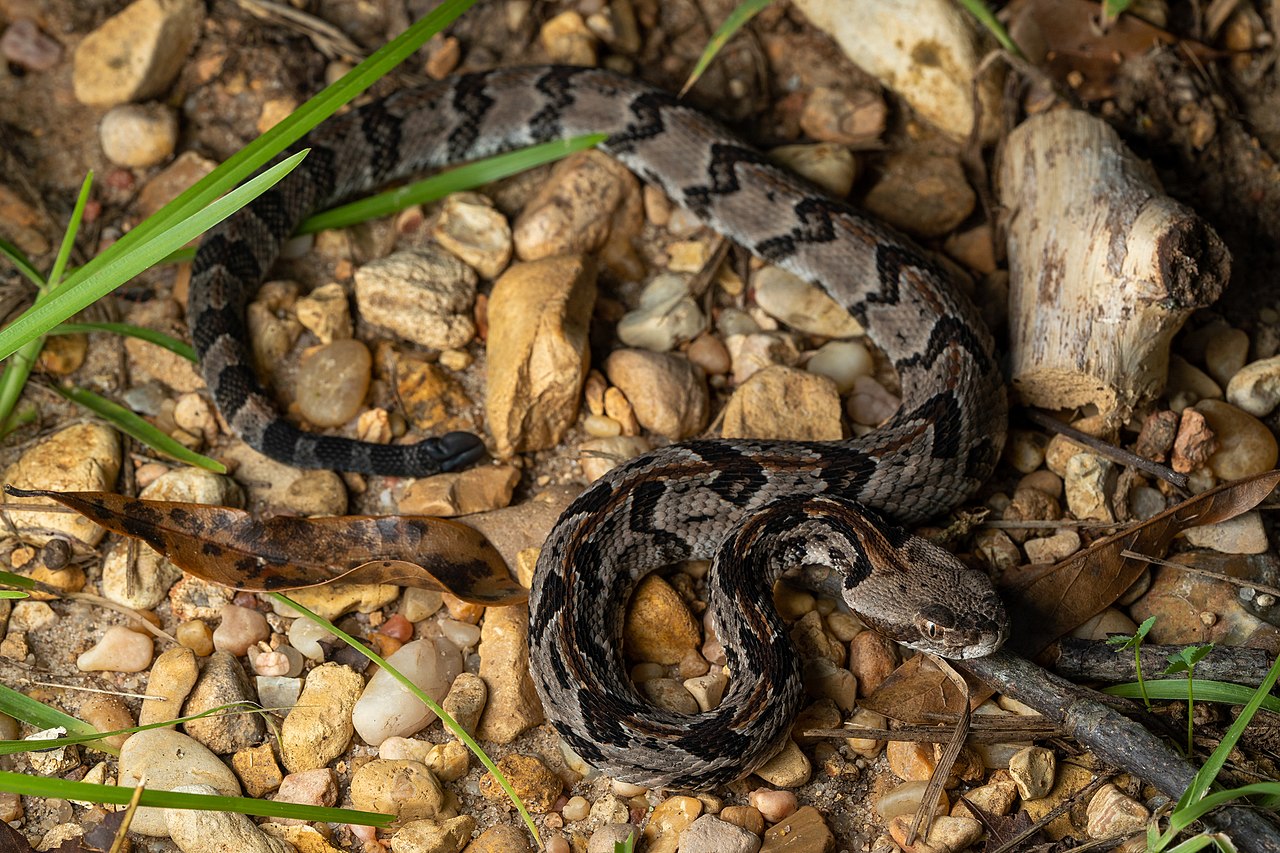
Scientific name: Crotalus horridus.
Venomous: Yes.
Timber Rattlesnakes are a venomous species with a presence in the Eastern parts of the state.
This snake has a dark brown body with darker crossbands. Some snakes of the species also have a central dorsal line, a trait typical to the snakes in Southern Oklahoma.
The species grows to a maximum size of 50 inches but many snakes measure around 40 inches as adults.
It lives in woodlands or wooded areas with rocky formations.
Rocks are an integral part of the lives of these snakes. They crawl below rocks or into other sheltered areas to overwinter.
The species moves along the ground for food. Rodents are its primary food in woodlands.
Timber Rattlesnakes may also feed in late fall or early spring.
22. Eastern Copperhead

Scientific name: Agkistrodon contortrix.
Venomous: Yes.
Eastern Copperheads are venomous snakes sometimes found in Oklahoma. They are seen across Eastern parts of the state as they have no presence in Western Oklahoma.
Eastern copperheads are venomous snakes that eat rodents. These snakes can have a positive role in the ecosystem by reducing rodent populations across the state.
Eastern Copperheads can find mice and rats at any moment using their heat-sensing pit between the eyes.
To a lesser extent, this snake might also consider other types of prey.
Frogs and toads might be among the secondary options while insects and bugs may be occasionally or accidentally swallowed as well.
This species maintains a nocturnal hunting habit and it grows to a size of up to 3 feet.
23. Flat-headed Snake
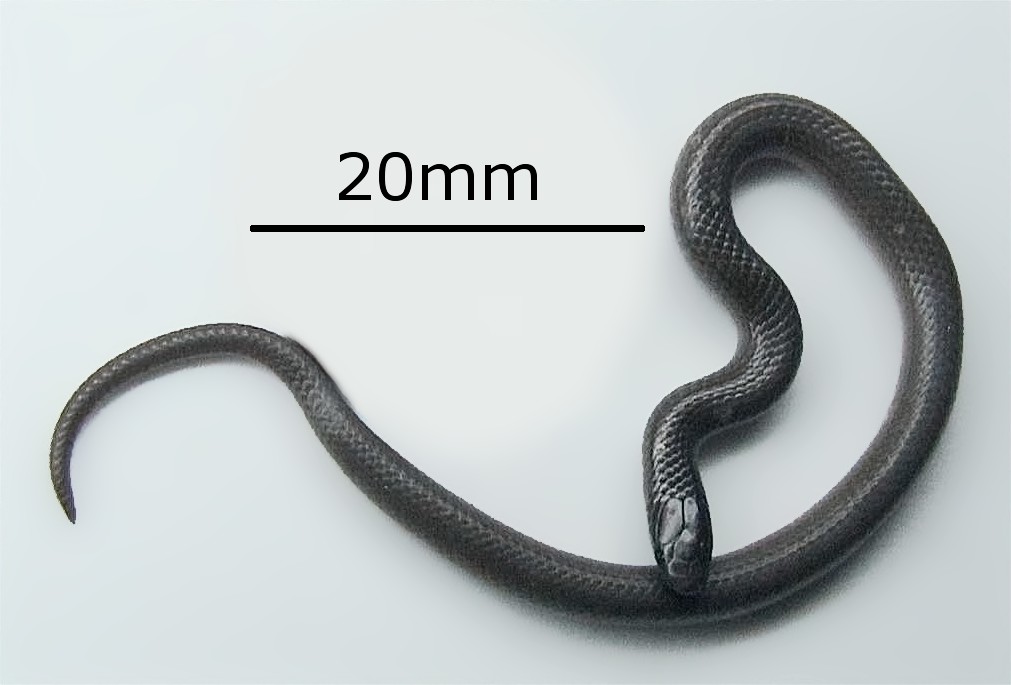
Scientific name: Tantilla gracilis.
Venomous: No.
This colubrid snake is sometimes seen across remote areas of the state.
It has a dark brown, light, brown, or tan body color with a contrasting black head.
Flat-headed Snakes are further known for having pink, dark pink, or red ventral coloring.
This is also one of the shortest types of snakes found in Oklahoma as Flat-headed Snakes grow to 8 inches.
The reduced size of the species also dictates its diet. Arthropods are the bulk of its diet.
Spiders and centipedes are routinely eaten by this species.
A non-venomous species, this snake is no real threat to humans.
24. Graham’s Crayfish Snake

Scientific name: Regina grahamii.
Venomous: No.
This species is named after the crayfish it consumes.
The snake comes in different dark colors. This includes various shades of brown or gray.
Its ventral coloring is brighter, typically yellow, yellow-orange, or cream.
The non-venomous snake is known to grow to a maximum length of 28 inches. Its juveniles are born with a length of around 8 inches.
Graham’s Crayfish Snakes are tied to aquatic habitats. They live in marshes by are also common around streams and rivers.
Snakes of this genus hide under vegetation or rocks next to streams, lakes, and rivers.
It only comes out at night.
25. Ground Snake

Scientific name: Sonora semiannulata.
Venomous: No.
Seen around ditches and areas with vegetation and loose soil, Ground Snakes are a small species in the state.
The snake comes in different colors, even as an adult.
It can be red or orange but rare Ground Snake morphs might also be brown.
A nocturnal species, Ground Snakes often go for nocturnal prey as well.
Spiders, centipedes, and their larvae are among the common foods of the Ground Snake.
Other bugs and insects are also consumed by this snake.
Female ground snakes don’t bear live young. They lay eggs in the summer.
Loose soils are preferred to lay eggs.
26. Common Watersnake

Scientific name: Nerodia sipedon.
Venomous: No.
As its name implies, the Common Watersnake is a species that lives close to bodies of water.
Larger water sources such as rivers and wider streams are the homes of adults while adjacent smaller bodies of water are places for their juveniles to grow.
This species comes in different colors. Brown, gray, and even red nuances are seen on the Common Watersnake.
This species isn’t venomous but it lives in areas where other venomous snakes live and may be perceived as dangerous.
When humans hunt it due to mistaking it for other species it tends to release a foul smell. It can bite, at times.
Its bite might lead to prolonged bleeding.
It grows to an average size of between 4 and 5 feet.
27. Western Massasauga

Scientific name: Sistrurus tergeminus.
Venomous: Yes.
Western Massasauga snakes are present in Oklahoma.
This pit viper is a venomous snake with a high risk to humans as its bite may destroy skin and muscles.
The species is a very rare sight as it tends to move away from areas with economic activity or from areas where it sees humans.
Bites often occur when the snake is handled, poke, or accidentally stepped on while camping or hiking.
Rodents are the main prey for the adult snake.
Young Western Massasaugas feed on reptiles.
Both adults and young Western Massasauga snakes may also consume frogs.
28. Prairie Rattlesnake

Scientific name: Crotalus viridis.
Venomous: Yes.
Prairie Rattlesnakes of different coloring are native to the state.
Western Oklahoma has these snakes as they aren’t seen in other regions of the state.
Seen in different subspecies and different colors, this snake may appear brown, light brown, green, gray, or a combination of these colors.
As a pit viper, the species is considered venomous with a nerve-affecting venom.
This species lives in different undisturbed habitats, mainly in areas with scarce or short to medium-height vegetation where other animals can live.
This includes ground-dwelling mammals, rodents, squirrels, and other snakes.
Small reptiles aren’t on the radar of adult Prairie Snakes.
29. Banded Watersnake

Scientific name: Nerodia fasciata.
Venomous: No.
This snake also comes in different colors such as dark green or dark gray with bright yellow or brown patterns.
The species is a watersnake seen across ponds, rivers, and streams of the state.
It rarely leaves the habitat of the water where it finds some of its preferred foods.
This snake prefers small fish and frogs. It resists toxic compounds found in some frog species.
Banded watersnakes grow to 42 inches but not in Oklahoma. Florida is the home of the largest snakes of this genus.
30. Great Plains Ratsnake

Scientific name: Pantherophis emoryi.
Venomous: No.
Identified by its large brown blotches, this is one of the most sedentary snakes in the state.
An occasional sight on farms, the snake is seen on farmland and on abandoned crops where it feeds on rats.
It prefers farms where rats might be looking for grains to feed on.
This snake may only come out at night which means it’s not spotted in many of its natural habitats.
Great Plains Ratsnakes are also known for occasionally eating other animals and small birds on farms.
It might also be referred to as the Chicken Snake as a result.
31. Western Milksnake

Scientific name: Lampropeltis gentilis.
Venomous: No.
Red coloring dominates the Western Milksnake. This species has black and white or yellow bands across its body.
Some snakes of the species have dark red or brown-red base coloring.
This species isn’t venomous.
Often thought to consume milk, this species only eats bugs, insects, and worms.
Earthworms and crickets or other bugs common in vegetation are part of the diet of Western Milksnakes.
Young Western Milksnakes feed on reptiles and other juveniles.
This species lays eggs. Up to a few eggs are laid in clusters each year.
32. Western Worm Snake
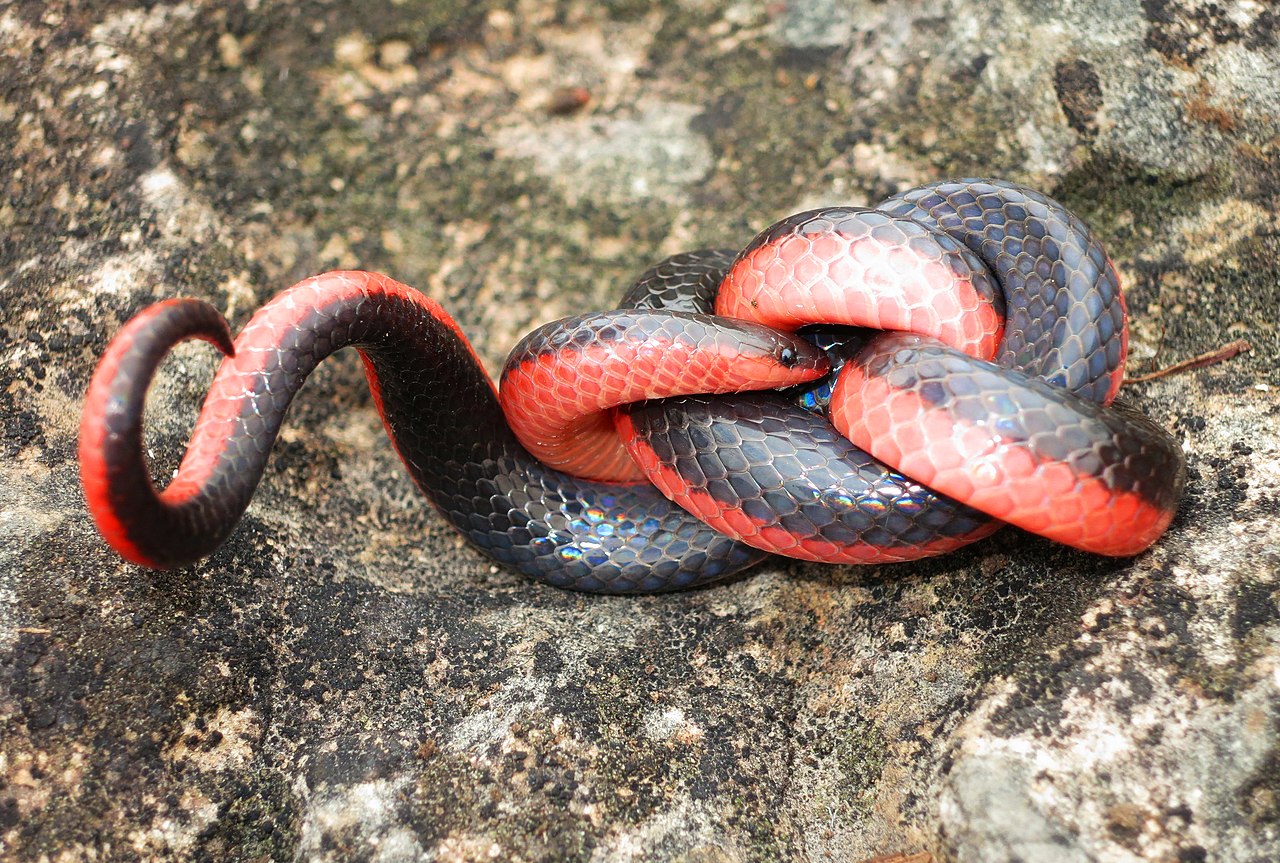
Scientific name: Carphophis vermis.
Venomous: No.
This small snake species measures anywhere up to 11 inches.
It has a dual-color body with a typical black dorsum. Red, pink, or orange ventral coloring is specific to the species.
Its underbelly is always lighter than its dorsal color.
Western Worm Snakes dig through loose soil for worms and bugs to eat.
They are highly secretive as they rarely surface out in the open.
Female Western Worm Snakes are known for laying eggs once per summer. Up to 8 eggs can be laid in clusters.
Some females might also lay only one egg, typically towards the end of cold summers.
Newly-emerged Western Worm Snakes measure a maximum of 4 inches, doubling their size until reaching adulthood.
This species is generally docile in its relationship to humans.
Rough handling or poking the snake triggers defensive reactions such as releasing a foul smell.
33. Checkered Garter Snake

Scientific name: Thamnophis marcianus.
Venomous: No.
Checkered Garter Snakes have long been believed not to be venomous.
This species is now seen as a mildly venomous snake. It poses no direct threats to human lives as it only has a small amount of venom.
This small amount is sufficient for its small prey. The snake uses different biting techniques to spread as much venom around its prey as possible.
Frogs and toads are commonly eaten by the species which may also consume fish.
Checkered Garter Snakes typically have a green color with checkered black spots and white stripes.
The species has a similarly-colored head.
Checkered Garter Snakes grow to a maximum length of 42 inches.
Various fields with short or medium-height grasses are ideal habitats for the species. Since it likes frogs and toads, this snake is also a common sight across fields next to water or marshes.
34. Texas Blind Snake

Scientific name: Rena dulcis.
Venomous: No.
This shiny short snake has a growing habitat across the state.
It has a dark color and it resembles earthworms.
Fossorial by nature, Texas Blind Snakes are among the common species that spend their lives underground.
They don’t need to come out as they often eat insects they find in the ground, together with their larvae.
It feeds on many types of termites in the state from Oklahoma City to Muskogee.
This snake species might surface during or after heavy rain.
Texas Blind Snakes often surface with springtime floods.
This is a time when this short snake that measures a maximum of 11 inches might be associated with other surfacing species such as earthworms.
35. Glossy Snake

Scientific name: Arizona elegans.
Venomous: No.
These snakes are also known as Faded Snakes given they have light brown colors and patterns.
The species is non-venomous and it grows to a maximum length of 50 inches.
Such large snakes are rare across the state as most only grow to a range between 30 and 40 inches.
Glossy Snakes are among the most common species to be nocturnal across arid lands.
It prefers harsh conditions of low humidity where it comes out at night to avoid daytime heat.
Glossy snakes feed on various types of nocturnal and diurnal prey such as small lizards.
Early summers are always marked by the emergence of new Glossy Snakes.
36. Plains Hognose Snake

Scientific name: Heterodon nasicus.
Venomous: No.
Known for its upturned snout, the Plains Hognose Snake may sometimes be seen in open areas or habitats close to the water in the state.
This species is known for favoring frogs and toads, species tied to high-humidity areas such as marshes, ditches, or grassy areas next to streams, rivers, and ponds.
This species is diurnal and sometimes encountered by humans hiking.
Mimicking a possible bite is typical to this species, as it is to other upturned snout snakes.
37. Chihuahuan Nightsnake
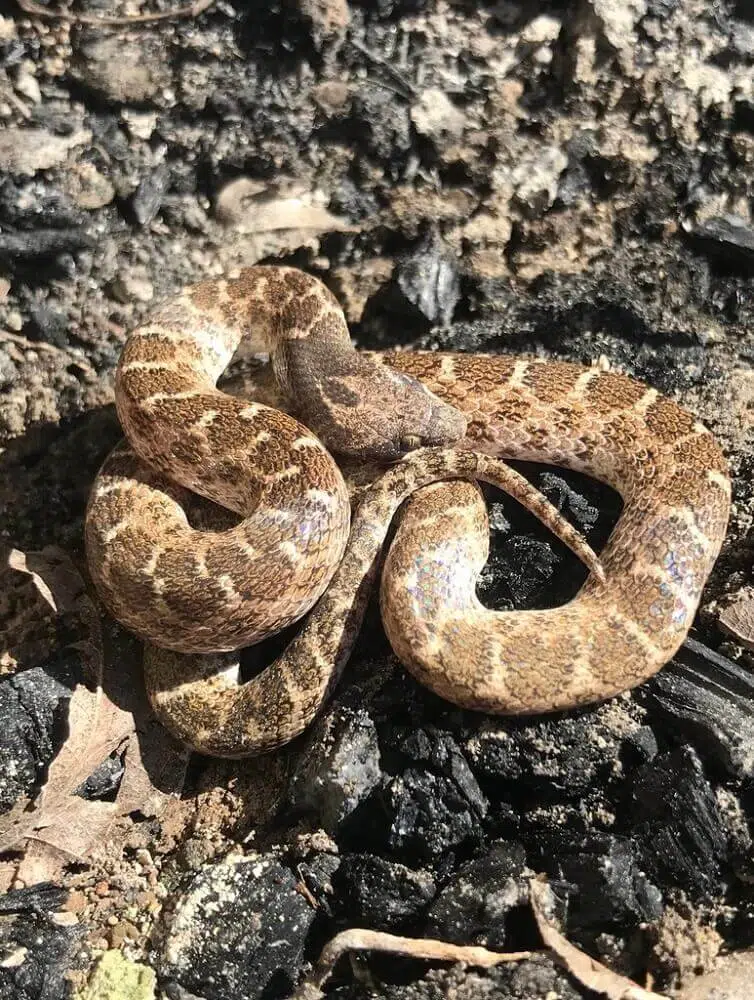
Scientific name: Hypsiglena jani.
Venomous: No.
Rocky grounds in the Southwestern parts of the state might sometimes be home to this snake species.
A gray or brown color with a dark brown or black head is specific to the Chihuahuan Nightsnake.
These species show distinct traits such as having mild venom for a species its size.
It grows to a maximum size of 21 inches with most species being at least 6 inches shorter, on average.
Lizards and insects are among the most common prey for the species.
38. Plains Black-headed Snake

Scientific name: Tantilla nigriceps.
Venomous: No.
This colubrid snake species is a common sight even in suburban areas.
Only seen when seeking moist areas such as man-made structures and basements for shelter, the Plains Blackhead Snake is named after the color of its head.
It’s the head that’s black while the rest of the body is brown or dark brown.
This species might be seen in an expanded season but most sights are tied to the egg-laying period of the summer.
Snakes of this genus prefer to remain hidden on hot summer days, preferably under vegetation.
39. Smooth Earthsnake
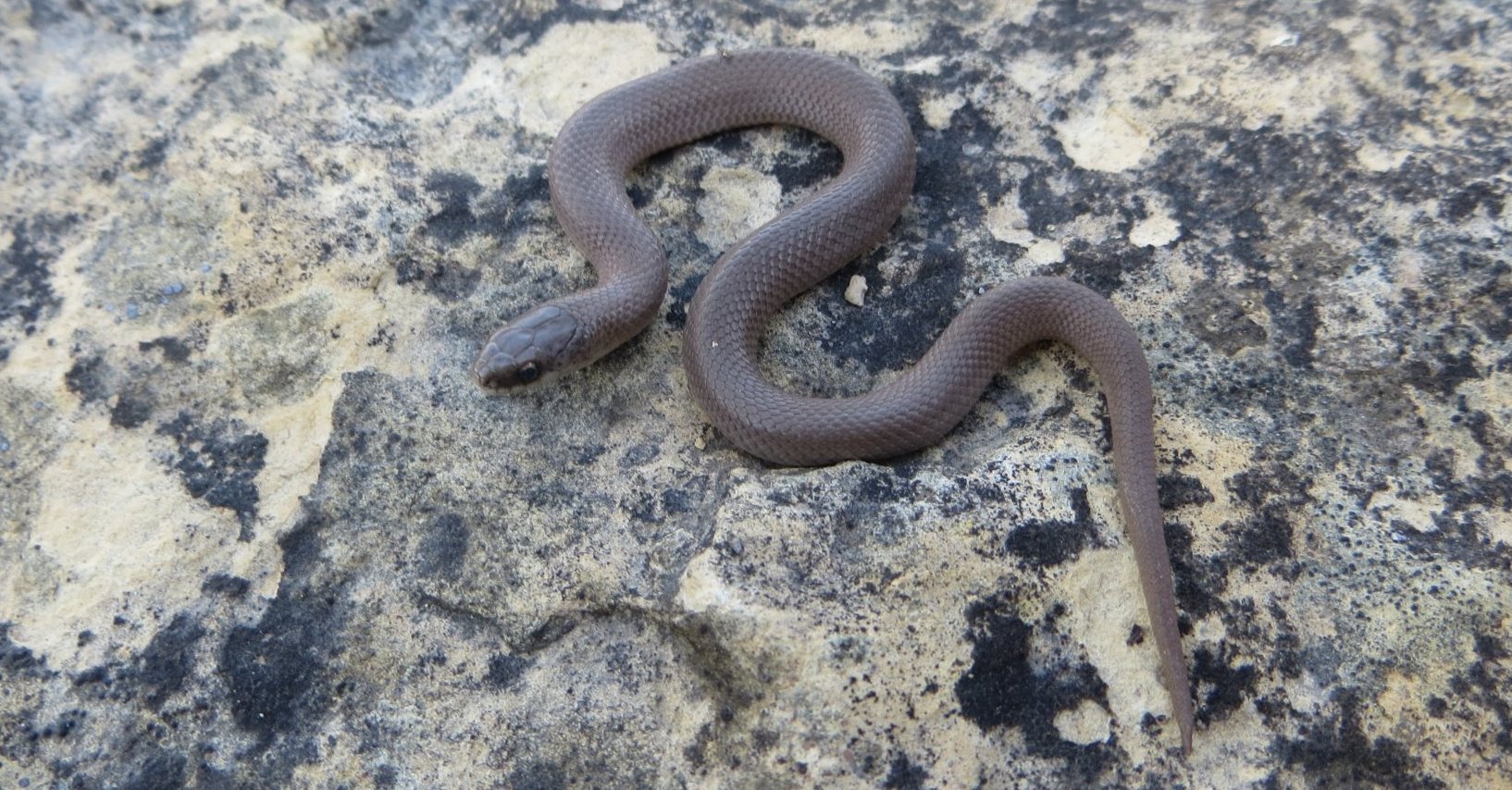
Scientific name: Virginia valeriae.
Venomous: No.
This type of snake is often confused with earthworms, particularly in its red color.
Smooth Earthsnakes also come in gray coloring and it grows to a maximum length of 10 inches.
Fossorial by nature, this species feeds on earthworms.
It also hides under large objects which offer a shaded humid place for them to live, such as under logs.
While a small snake species, the female Smooth Earthsnake gives birth to live young.
Up to 14 juveniles are born each year.
40. Red-bellied Snake

Scientific name: Storeria occipitomaculata.
Venomous: No.
Red-bellied Snakes are one of the multiple types of fossorial snakes in the state.
This species has a dark dorsal color and a black head.
It lives underground, in loose soil.
Soft types of prey such as earthworms are its primary food source.
This species is only present in the Southern parts of the state as the species is endemic to Southern US territories.
It can be handled as it’s not venomous. However, the species might still attempt to bite, without great risk to the skin given it only has small teeth.
41. Plains Garter Snake

Scientific name: Thamnophis radix.
Venomous: No.
A dark-colored species, the Plains Garter Snake is only contrasted by orange and yellow stripes.
These stripes are only seen on its dorsal side as they run from head to tail.
Snakes of the genus are known for living close to water sources also favoring humid lands.
Worms and slugs are among the types of prey Plains Garter Snakes prefer.
Prairies are among the preferred vegetation-rich lands this species prefers.
It can also be found in abandoned homes around the state.
This species is known to be adaptive when it comes to living in different types of habitats out of its norm.
42. Long-nosed Snake

Scientific name: Rhinocheilus lecontei.
Venomous: No.
Similar to a Coral Snake, the Long-nosed Snake has red, black, and red coloring across its body.
This species has a white or an off-white underbelly.
The species is also known to have a distinctive upturned snout.
Long-nosed Snakes have adapted snouts for digging. These snakes look for food in the ground.
While nocturnal, they can still identify and catch lizards. Long-nosed Snakes only rarely eat mice and rats.
Defensive mechanisms of the species include releasing blood in a death-mimicking act.
43. Mudsnake
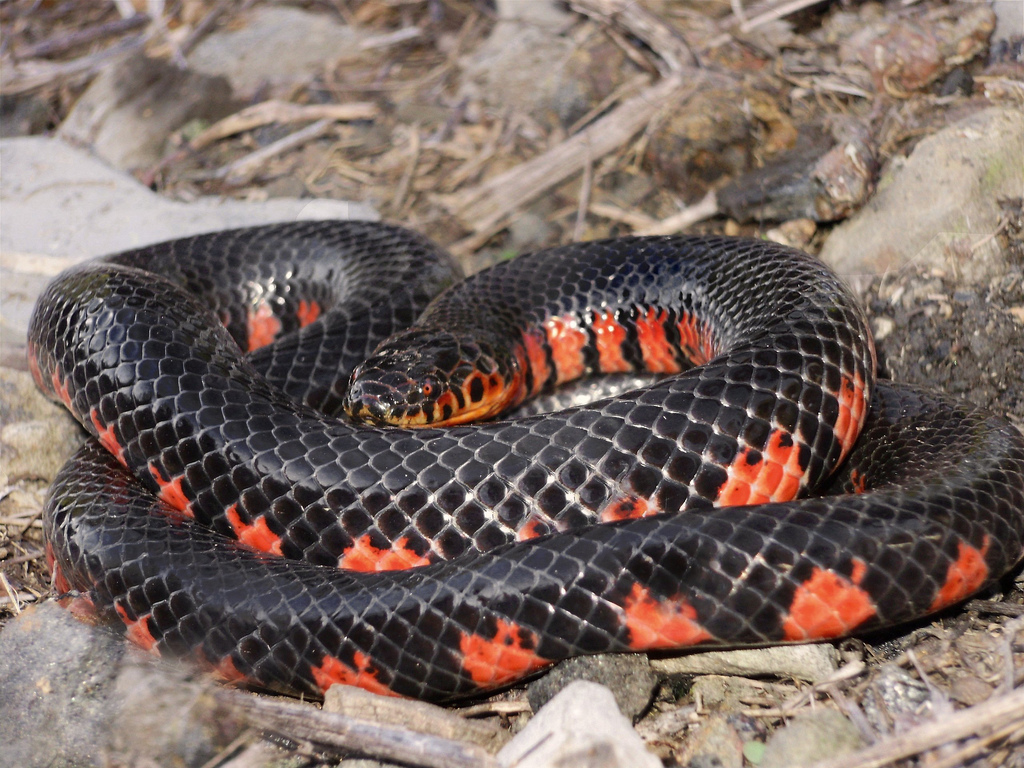
Scientific name: Farancia abacura.
Venomous: No.
This species lives both in the water and on dry land. It has a black body with red ventral coloring.
All types of nocturnal prey that favor humidity is eaten by Mudsnakes.
Mudsnakes often test out different types of prey by poking them with the tips of their tails.
You might find this species along streams and in swamps. It has a distinct robust body that grows to a maximum length of 51 inches.
44. Scarletsnake

Scientific name: Cemophora coccinea.
Venomous: No.
Scarletsnakes bear a physical resemblance to Coral Snakes.
A red body with white and black bands is characteristic of Scarletsnakes.
This is a slender species with a short body. It barely grows to a size of over 20 inches across the state.
Scarletsnakes are only seen during the summer months as they have secretive lives.
They might be seen either laying eggs or when looking for prey. Common Scarletsnake prey includes lizards and mice.
Scarletsnake eggs hatch in an interval between August and September.
This species has a pending endangered status.
45. Black-necked Garter Snake
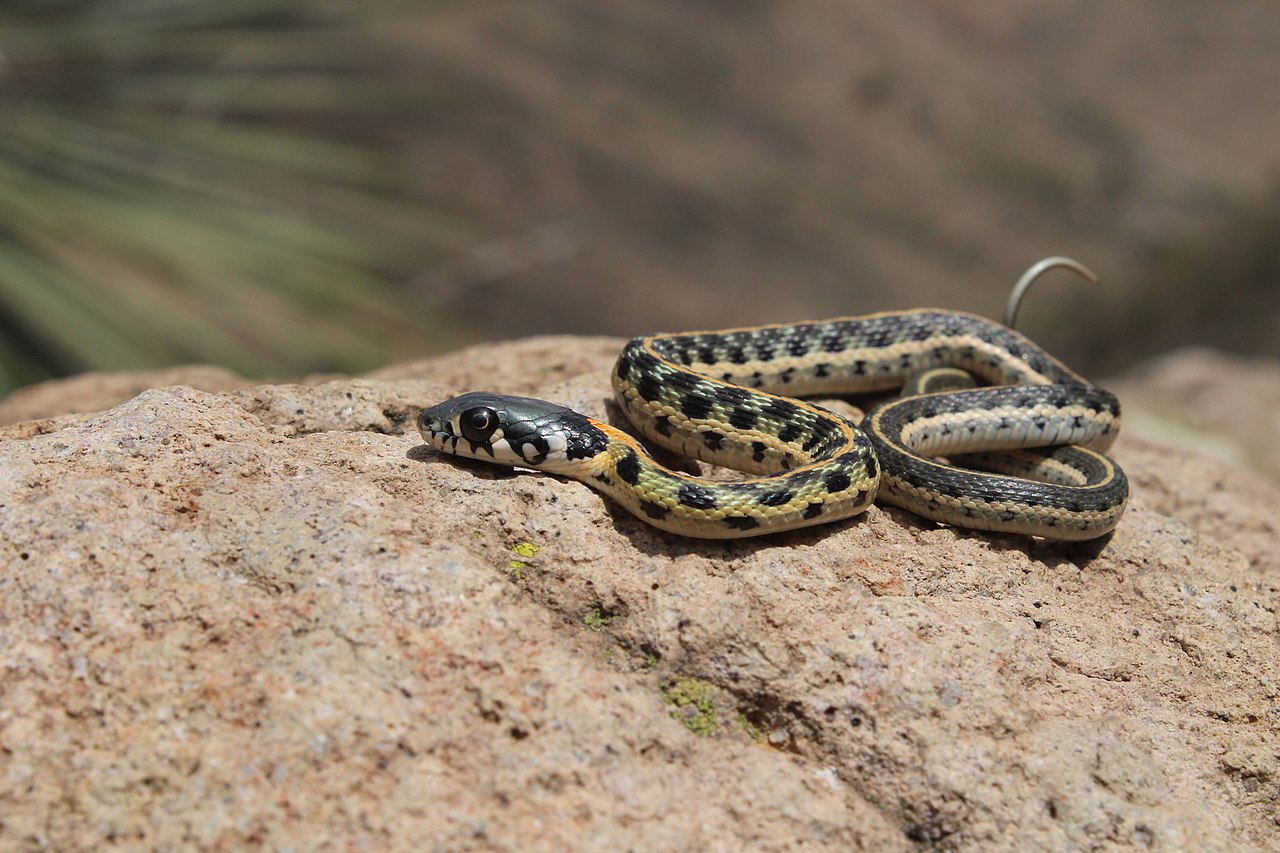
Scientific name: Thamnophis cyrtopsis.
Venomous: No.
This semi-aquatic species has a short body size and a distinct dark green-olive color.
Contrasting orange and white stripes run along its body.
Black-necked Garter Snakes are a rare sight across Southern regions of Oklahoma.
Grasslands and territories close to water are among their natural habitats.
Fish is among its preferred foods as the snake can swim.
The species is most active during the day but it may also come out for food at night.
46. Glossy Swampsnake

Scientific name: Liodytes rigida.
Venomous: No.
Crayfish is among the most common foods of the semi-aquatic Glossy Swampsnake.
The species is sometimes referred to as the Crayfish Snake given crayfish is almost its exclusive food.
Snakes of this species are also known as striped snakes. Dorsal stripes of a similar but darker green-gray color can sometimes be seen on the species.
Even the underbelly of the species shows dual longitudinal stripes or yellow or cream base color.
This species is seen around swamps with a growing presence in the Southern parts of Oklahoma.
The size of the Glossy Swampsnake tends to vary considerably.
Some medium-sized snakes have been identified within this species but most only grow to a 20-inch size.